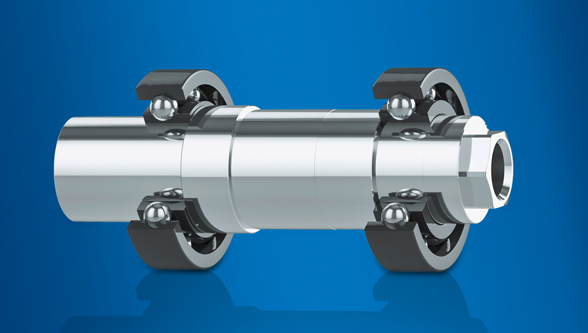HeavyDuty rotary encoders from Baumer Hübner are the “original”. More than half a century ago, Baumer Hübner developed this type of particularly reliable and robust rotary encoders. Since then they have been used in all situations where the going is tough and where failure is not an option. What distinguishes a HeavyDuty rotary encoder exactly and what options do they offer users ?
Dockside cranes that unload thousands of tons of shipped goods daily. Conveyor systems that carry thousands of tons of mined ore from mining plants across many kilometers. Elevators that carry thousands of people daily. Automated production lines on which automobiles in various assembly stages are transported. Lifting bridges with a total weight of 1000s of tons that can carry several trains at once and that are lifted many times per day to allow ships to pass. These and many other application scenarios constitute the world of HeavyDuty rotary encoders – anytime difficult tasks must be reliably carried out under difficult conditions and over the long term.
The term has been linked to Hübner Berlin since the 1950s, when the company established the supreme rotary encoder class. Since that time, Hübner Berlin, which today belongs to sensor specialist Baumer, has continuously improved its products and is still considered the expert provider of HeavyDuty rotary encoders. But what do we mean when we talk about HeavyDuty products? After all, the term is not legally protected or regulated by a standard. “Heavy duty” as such simply means hard-wearing. A possible reason why some people think that HeavyDuty rotary encoders are simply encoders with thick housing walls and rust protection. In reality, the term denotes much much more.
What makes a rotary encoder “HeavyDuty”?
To Baumer Hübner, “HeavyDuty” is an all-encompassing performance promise. First of all, this means that such a rotary encoder never lets its user down, even under the most difficult conditions. And secondly that these heavyweights work as precisely as “small” rotary encoders for an extended period of time. HeavyDuty rotary encoders from Baumer Hübner accomplish this through four characteristics:
Precision: A rotary encoder must deliver reliable signals to allow users to precisely control and regulate drives and generators. Plant control systems utilize these signals for speed monitoring of drives or for position feedback of machine parts. To controllers, this information is the only way to get informed and intervene, for example, if a drive exceeds or falls below a defined speed limit. Since the machines and systems are usually very big – dock cranes, bucket-wheel excavators, rolling mills, garbage shredders – they could give the above-mentioned impression that precision does not matter much. That is a mistake¤ Particularly because heavy loads are moved with great force, small measuring errors could have extensive consequences, for example, when setting down a container weighing several tons.
Mechanical robustness: a HeavyDuty rotary encoder must be so resilient that it can withstand hard shocks, vibration, and forces on the rotary encoder shaft for many years. Exchanging rotary encoders is expensive, not because of pricing but because of installation in places difficult to access and the system being down for the time of exchange. HeavyDuty rotary encoders are distinguished by several characteristics: Double-sided bearing setup with generously dimensioned, largely spaced bearings at both shaft ends to compensate axial and radial load, robust and thick-walled housings, and durable protection of the inside components against shocks and vibration.
Tightness: HeavyDuty rotary encoders are usually deployed in dusty, soiled, and damp environments. For this reason, the HeavyDuty encoder housing must be well sealed, especially at critical, neuralgic points – the shaft and electrical connections. Further, in terms of potential contact to chemicals or salt water, a good corrosion protection through appropriate housing materials and coatings is mandatory.
Electrical robustness: HeavyDuty rotary encoders must be immune against electromagnetic fields. These are generated by live, unshielded cables routed nearby, which is a quite common situation in many applications.Without adequate shielding, the electronics in the rotary encoder might be destroyed or provide erroneous measuring signals. Another point are shaft currents caused by potential differences. They may burn the bearing lubrication, which results in bearing destruction. For all these reasons, the inside electronics of HeavyDuty rotary encoders must be electrically isolated from the ambiance of operation.





